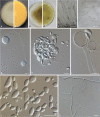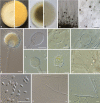A new species concept for the clinically relevant Mucor circinelloides complex
- PMID: 33116336
- PMCID: PMC7567969
- DOI: 10.3767/persoonia.2020.44.03
A new species concept for the clinically relevant Mucor circinelloides complex
Abstract
Mucor species are common soil fungi but also known as agents of human infections (mucormycosis) and used in food production and biotechnology. Mucor circinelloides is the Mucor species that is most frequently isolated from clinical sources. The taxonomy of Mucor circinelloides and its close relatives (Mucor circinelloides complex - MCC) is still based on morphology and mating behaviour. The aim of the present study was a revised taxonomy of the MCC using a polyphasic approach. Using a set of 100 strains molecular phylogenetic analysis of five markers (ITS, rpb1, tsr1, mcm7, and cfs, introduced here) were performed, combined with phenotypic studies, mating tests and the determination of the maximum growth temperatures. The multi-locus analyses revealed 16 phylogenetic species of which 14 showed distinct phenotypical traits and were recognised as discrete species. Five of these species are introduced as novel taxa: M. amethystinus sp. nov., M. atramentarius sp. nov., M. variicolumellatus sp. nov., M. pseudocircinelloides sp. nov., and M. pseudolusitanicus sp. nov. The former formae of M. circinelloides represent one or two separate species. In the MCC, the simple presence of well-shaped zygospores only indicates a close relation of both strains, but not necessarily conspecificity. Seven species of the MCC have been implemented in human infection: M. circinelloides, M. griseocyanus, M. janssenii, M. lusitanicus, M. ramosissimus, M. variicolumellatus, and M. velutinosus.
Keywords: Mucor; mating tests; maximum growth temperature; mucormycosis; new taxa; phylogeny; taxonomy; zygospore formation.
© 2019 Naturalis Biodiversity Center & Westerdijk Fungal Biodiversity Institute.
Figures























References
-
- Abe A, Asano K, Sone T. 2010. A molecular phylogeny-based taxonomy of the genus Rhizopus. Bioscience, Biotechnology, and Biochemistry 74: 1325–1331. - PubMed
-
- Aguileta G, Marthey S, Chiapello H, et al. 2008. Assessing the performance of single-copy genes for recovering robust phylogenies. Systematic Biology 57: 613–627. - PubMed
-
- Álvarez E, Cano J, Stchigel AM, et al. 2011. Two new species of Mucor from clinical samples. Medical Mycology 49: 62–72. - PubMed
-
- Álvarez E, Stchigel AM, Cano J, et al. 2010. Molecular phylogenetic diversity of the emerging mucoralean fungus Apophysomyces: proposal of three new species. Revista Iberoamericana de Micología 27: 80–89. - PubMed
LinkOut - more resources
Full Text Sources
